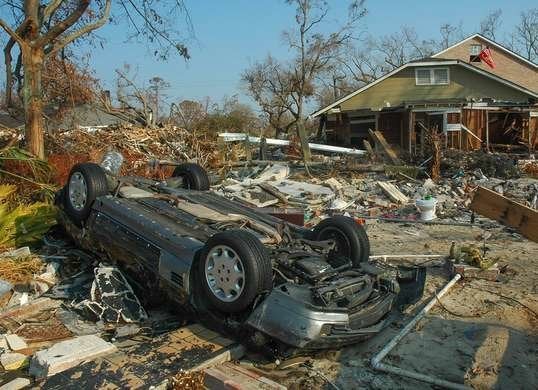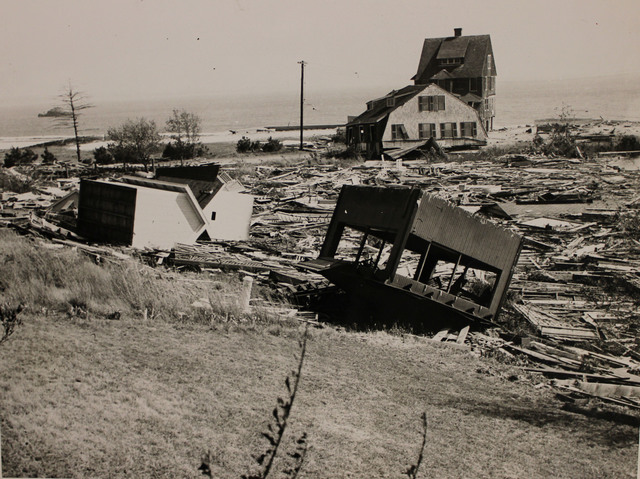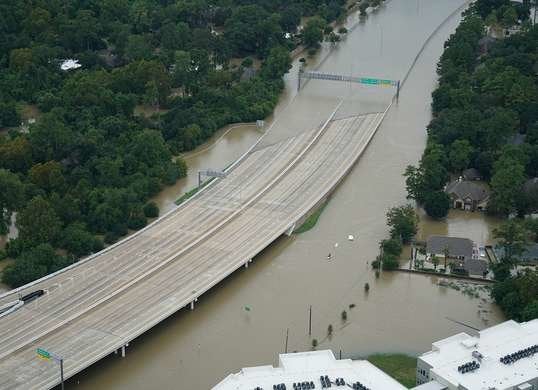We may earn revenue from the products available on this page and participate in affiliate programs. Learn More ›
Hurricane season, which officially runs from June 1 to November 30, is reaching its peak along the southern and eastern coastlines. The National Oceanic and Atmospheric Administration (NOAA) is predicting a range of 12 to 17 total named storms this season (with winds of 39 miles per hour or higher). Between five to nine of these storms could become hurricanes (with winds of 74 mph or higher), and one to four could become major hurricanes with winds of 111 mph or higher. NOAA relies on a variety of tools to predict hurricanes, including more than 150 years of data on some of the most devastating storms ever to have hit the mainland.
As reported by NOAA, natural disaster damages from 2022 totaled approximately $165 billion, with the costliest event being Hurricane Ian, which came in at roughly $113 billion. In short, storms are exceptionally dangerous and costly, in terms of both property and lives. To illustrate the destructive power of hurricanes, we’ve rounded up the worst storms on record ever to have hit the United States.
1. The Galveston Hurricane (August to September 1900)

The deadliest hurricane in U.S. history was the 1900 Galveston Hurricane, a Category 4 storm that began in August of that year. The hurricane essentially obliterated the city of Galveston, Texas, on September 8, 1900. It is estimated that 8,000 to 12,000 people lost their lives in this storm, which lashed the city with winds of up to 143 mph and a storm surge of 8 to 15 feet. More than 3,600 homes were destroyed, leaving 10,000 people homeless, and the hurricane caused an estimated $30 million in damages (nearly $727 million in 2023 dollars). Galveston’s geography makes it a hotspot for future storms, and NOAA forecasts that the city could be plagued by chronic flooding by the year 2030 if nothing is done to address human-caused climate change.
RELATED: 9 Ways Natural Disasters Are Changing Your Local Building Codes
2. Hurricane Maria (September 2017)

Although it did not reach the mainland, Hurricane Maria is one of the deadliest and costliest storms to ever hit a U.S. territory. It made landfall near Yabucoa, Puerto Rico, as a Category 4 storm on September 20, 2017, with winds of 155 mph. The hurricane completely destroyed the island’s power grid, leaving more than 3 million residents without electricity. More than 3,000 people lost their lives, and damages were estimated in excess of $117 billion (in 2023 dollars). Scientists at the University of Alabama in Tuscaloosa and Sonoma State University in California later released a paper indicating that the severe rains seen during Hurricane Maria are five times likelier today than in 1950, an increase they link to climate change.
3. Okeechobee Hurricane (September 1928)

The 1928 Okeechobee Hurricane, also known as the San Felipe Segundo hurricane, claimed 2,500 to 3,000 lives in Central Florida, making it the second-deadliest hurricane in U.S. history. Along the storm’s entire path, some 4,112 people lost their lives. The hurricane hit Puerto Rico as a Category 5 with winds of 160 mph on September 13, 1928. Nearly 25,000 homes were destroyed and around 192,000 were damaged, leaving more than 500,000 people homeless. The storm reached the mainland as a Category 4 with winds of 145 mph near West Palm Beach, Florida, on September 17. The storm surge caused water to pour out of Lake Okeechobee, flooding hundreds of square miles to depths as great as 20 feet. More than 1,700 homes were destroyed in West Palm Beach, and numerous houses and other buildings were swept away in Belle Glade, Canal Point, Chosen, Pahokee, and South Bay. The storm continued up the Eastern Seaboard and caused $1.8 billion in damages (in today’s dollars).
RELATED: How To: Prepare for a Hurricane
4. Hurricane Katrina (August 2005)

Although it is not the largest storm recorded, Hurricane Katrina in 2005 was by far the costliest hurricane in U.S. history, with property damage estimated at more than $125 billion ($195 billion in 2023 dollars). Katrina was a Category 5 hurricane that first hit Florida on August 25, 2005, as a Category 1 storm and then intensified before slamming into New Orleans and surrounding areas in Louisiana. Much of the damage was due to a storm surge that caused more than 50 breaches in the surge protection levees surrounding New Orleans, flooding 80 percent of the city. The surge peaked at an estimated 28 feet, the highest surge on record in the United States. Katrina damaged or destroyed 30 oil platforms and caused the closure of nine refineries. Federal disaster declarations covered 90,000 square miles, an estimated 3 million people lost electricity, and more than 1,800 people died in the storm and its aftermath.
5. Cheniere Caminada Hurricane (September to October 1893)

Also known as the Great October Storm, this Category 4 hurricane struck Cheniere Caminada in Louisiana on October 2, 1893. The storm claimed an estimated 2,000 lives; more than half the population of Cheniere Caminada lost their lives in the storm. Winds of 135 mph and a storm surge of 16 feet wiped out homes and businesses throughout Louisiana, Mississippi, Alabama, and Florida, causing an estimated $170 million in damages (in 2023 dollars).
6. Sea Islands Hurricane (August 1893)

The Sea Islands Hurricane, which struck the Sea Islands, near Savannah, Georgia, in August 1893, was one of the deadliest storms in U.S. history. The Category 3 hurricane caused widespread devastation, with an estimated death toll of approximately 2,000 people. The storm left upwards of 30,000 people homeless, as nearly every building on the Sea Islands was damaged beyond repair. Damages from the hurricane totaled at least $1 million (roughly $34 million today).
7. New England Hurricane (September 1938)

The 1938 New England Hurricane struck Long Island, New York, and New England in September of 1938. The Category 3 hurricane reached wind speeds of 120 mph and caused an estimated 682 to 800 deaths. The storm resulted in widespread damage to property, infrastructure, and landscapes, and cost an estimated $306 million in 1938 (that’s equivalent to roughly $6.6 billion today).
8. Hurricane Audrey (June 1957)

This Category 4 hurricane struck southern Louisiana and southeast Texas in 1957, with powerful winds and storm surge that left devastation in its wake. Winds reached speeds of up to 127 mph, and the storm took approximately 500 lives. Hurricane Audrey cost nearly $150 million in 1957, which is about $1.6 billion today.
9. Great Labor Day Hurricane (August to September 1935)

The most intense hurricane ever to hit the United States slammed into the Florida Keys on September 2, 1935. Registering the lowest-ever sea level pressure of 892 millibars at landfall, this was the first known Category 5 hurricane to strike the mainland United States. The Labor Day hurricane is tied with Hurricane Dorian, which hit the Bahamas in 2019, for maximum sustained winds, estimated at 185 mph, and the storm surge reached 20 feet. The hurricane caused catastrophic damage in the Florida Keys, destroying nearly all structures between Tavernier and Marathon; the town of Islamorada was obliterated. Portions of the Key West Extension of the Florida East Coast Railway were severely damaged or destroyed. The hurricane also caused damage in northwest Florida, Georgia, and the Carolinas. According to NOAA, 408 people lost their lives, many of them World War I veterans who were working on construction projects in the Keys. A train sent from Miami to evacuate them never arrived; most of it was swept from the tracks by the hurricane.
10. Great Atlantic Hurricane (September 1944)

The Category 3 Great Atlantic Hurricane caused extensive damage to New England, North Carolina, New York, and parts of Canada. The storm generated winds of up to 160 mph and killed approximately 390 people along World War II shipping lines. Five ships sank during the storm, including two U.S. Coast Guard cutters off the coast of North Carolina and a U.S. Navy destroyer near Florida. The hurricane cost over $100 million in 1944, which would be approximately $1.7 billion in today’s dollars.
11. Great Miami Hurricane (September 1926)

This Category 4 storm hit Miami on September 18, 1926, and caused widespread devastation across Florida, Alabama, Louisiana, and Mississippi. The Red Cross reported that 372 people lost their lives in the storm, which produced a storm surge of 10 feet on Miami Beach. The surge breached the dike that protected the town of Moore Haven from the waters of Lake Okeechobee, causing severe flooding that persisted for weeks. Damages in 1926 dollars were estimated at $105 million, which would be more than $1.8 billion today.
12. Hurricane Camille (August 1969)

The highest recorded wind speed at landfall worldwide was reached by Hurricane Camille, which had winds estimated at 190 mph when it hit the Mississippi Gulf Coast on August 17, 1969; the actual maximum sustained winds will never be known because the hurricane destroyed the wind-recording instruments. The storm surge from Camille was 24 feet, the highest on record until Katrina. Camille caused damage throughout the Gulf Coast region and as far north as Virginia, with 259 people losing their lives, 8,931 people injured, 5,662 homes destroyed, and 13,915 homes that sustained major damage. The storm caused an estimated $1.42 billion in damages (equivalent to $11.8 billion in today’s dollars).
13. Hurricane Sandy (October to November 2012)

When Hurricane Sandy, also known as Superstorm Sandy, merged with a winter storm in late October 2012, the result was the largest diameter Atlantic hurricane on record, with tropical-storm-force winds that spanned 900 miles. The storm affected 24 states, including the entire Eastern Seaboard from Florida to Maine, and reached as far west as Michigan and Wisconsin. The storm surge was particularly devastating to New Jersey and New York, where streets, tunnels, subway lines, and coastal areas flooded. Nearly 20,000 flights were canceled across the country, Amtrak shut down most of its Northeast train service for 2 days, and the New York Stock Exchange and Nasdaq were also closed for 2 days. More than 8.5 million people in the Northeast lost power, 650,000 houses were either damaged or destroyed, and at least 233 people in eight countries lost their lives. Sandy caused an estimated $70 billion in damage.
RELATED: How to Survive a Hurricane: 21 Smart Preps You Can Make Now
14. Hurricane Ian (September 2022)

Hurricane Ian has been described as the third-costliest weather disaster recorded in history and the most expensive hurricane to strike Florida. The Category 5 hurricane reached wind speeds as high as 160 mph and was responsible for approximately 161 lives lost; one person’s remains were found just this year in Lee County. Damage from the hurricane is reported to have cost $113 billion as of 2022.
15. Hurricane Agnes (June 1972)

The effects of Hurricane Agnes, also referred to as the flood of 1972, were widespread, with much of the United States East Coast greatly affected. The Category 1 hurricane brought heavy rains and flooding to several states, with Pennsylvania being the hardest hit, and claimed approximately 128 lives. It’s estimated to have cost more than $2.1 billion (roughly $15.3 billion today).
RELATED: 11 Things You Should Never Do During a Hurricane
16. Hurricane Michael (October 2018)

Hurricane Michael made landfall as a Category 5 hurricane on October 10, 2018, near Mexico Beach, Florida. With wind speeds reaching up to 160 mph, it was the first Category 5 hurricane to strike the United States since Andrew in 1992. The storm’s immense power caused widespread destruction in the Florida Panhandle and parts of Georgia, resulting in 74 fatalities. It’s estimated to have cost $25.5 billion in 2018.
17. Hurricane Harvey (August 2017)

The Category 4 Hurricane Harvey, which made landfall at San José Island, Texas, on August 25, 2017, is tied with Hurricane Katrina as the costliest on record, inflicting an estimated $125 billion in damage that was centered on the Houston metropolitan area and southeast Texas. An estimated 300,000 structures were damaged or destroyed as well as more than half a million vehicles. Locations in Houston recorded more than 30 inches of rainfall within a 3-day period. Approximately 336,000 people were left without electricity and at least 68 people lost their lives. World Weather Attribution claims that with Harvey, Americans saw the impact of human-induced climate change on extreme weather events. The record rainfall was “15 percent heavier and three times more likely because of climate change.”
Related: Solved! Which Flood Zones Require Flood Insurance?
18. Hurricane Andrew (August 1992)

Hurricane Andrew was a Category 5 storm that made landfall in South Florida with the second-highest recorded wind speed, estimated at 167 mph; because most of the instruments were destroyed, actual sustained wind speeds are unknown. The storm, which struck Elliott Key in Florida on August 24, 1992, was the most destructive hurricane to hit Florida in terms of the number of structures damaged or destroyed. More than 63,500 houses were destroyed, more than 124,000 were damaged, and total damages were estimated at $27.3 billion. Andrew caused extensive damage to oil platforms in the Gulf of Mexico, leading to $500 million in losses for oil companies. The storm made a second landfall in Louisiana as a Category 3 storm, leaving about 230,000 people without electricity. In total, 65 people lost their lives.


